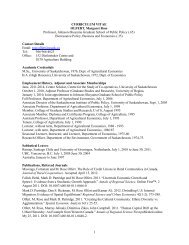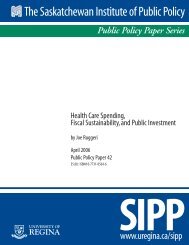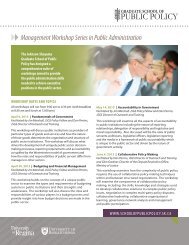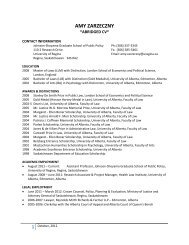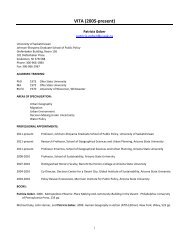Download Evelyn Peters' CV. - Johnson-Shoyama Graduate School ...
Download Evelyn Peters' CV. - Johnson-Shoyama Graduate School ...
Download Evelyn Peters' CV. - Johnson-Shoyama Graduate School ...
- No tags were found...
You also want an ePaper? Increase the reach of your titles
YUMPU automatically turns print PDFs into web optimized ePapers that Google loves.
CURRICULUM VITAENAME: <strong>Evelyn</strong> Joy PetersADDRESS: Department of GeographyUniversity of Saskatchewan9 Campus DriveSaskatoon, SaskatchewanS7N 5A5Work: (306) 966-5639Home: (306) 477-7480Fax: (306) 966-5680E-mail: evp818@mail.usask.caCITIZENSHIP: CanadianMARITAL STATUS: Married, with two children,Rachel, age 17, and Matthew, age 19EMPLOYMENT RECORD2008 - Professor and Canada Research Chair (Tier II)Department of Geography and <strong>Johnson</strong>-<strong>Shoyama</strong> <strong>School</strong> of Public Policy,University of Saskatchewan2007 - 2008 Professor and Canada Research Chair (Tier II)Department of Geography, University of Saskatchewan2001 - 2007 Associate Professor and Canada Research Chair (Tier II)Department of Geography, University of Saskatchewan1994- 2001 Associate Professor, Department of Geography,Queen's University, Kingston1994-1995 Fellow, Institute of Intergovernmental Relations,Queen's University, Kingston1993-1994 Canada Research Fellow and Associate Professor,Department of Geography, Queen's University,1991-1993 Canada Research Fellow and Assistant Professor,Department of Geography, Queen's University1990-1991 Canada Research Fellow, Department of Geography,Carleton University, Ottawa1987-1990 Assistant Professor (adjunct), Department of Geography,Queen's University1986-1987 Research Associate, Institute of Intergovernmental Relations,Queen's University, Kingston1978-1986 Lecturer and Teaching Assistant, Department of Geography,1
Queen's University, Kingston2
EDUCATIONDegreesPh.D., Geography, Queen's University, 1988. Thesis Title: Indians in Regina and Saskatoon, 1982:Strategies of Household OrganizationM.A., Geography, Queen's University, 1981. Thesis Title: Native Households in Winnipeg: Co-Residenceand Financial SupportB.A. (Honours), Geography, University of Winnipeg, 1978. Thesis Title: The Hudson's Bay Company andPrairie Town Development, 1870-1888AWARDS AND HONOURSErskine Fellowship, University of Canterbury, Christchurch, NZ, June – November, 2006Canada Research Chair, 2001-2011In 2004, my graduate students at Queen‟s and the University of Saskatchewan nominated me for theCanadian Association of Geographer‟s Excellence in Teaching Award. (not awarded)Awarded the Julian Seicz Excellence in Teaching Award, Department of Geography, Queen’s, 2001.Canada Research Fellowship. 1990-93Ontario <strong>Graduate</strong> Scholarship, 1984-85CMHC <strong>Graduate</strong> Scholarship, 1981-84CMHC <strong>Graduate</strong> Scholarship, 1978-1981University of Winnipeg Gold Medal in Geography, 1978University of Winnipeg Silver Medal, 2nd Highest Standing in Arts (Honours), 1978Humboldt Scholarship, University of Winnipeg, 1976Board of Regents; General Proficiency Scholarship, University of Winnipeg, 1974, 1976TEACHINGUndergraduateGPHY 100/120: Geography and the Environment (Queen‟s)GPHY 223: Foundations of Urban Geography (Queen‟s)GPHY 225 Foundations of Social Geography (Queen‟s)GPHY 338: Urban Political Geography (Queen‟s)GPHY 350/351: Geographies of Aboriginal Peoples in Canada (Queen‟s)GPHY 352: Gender and the City (Queen‟s)GPHY 491: Honours Seminar in the Geographies of Cultural and Social Change (Queen‟s)GPHY 492: Honours Seminar in Cities and Regions (Queen‟s)GPHY 501: Special Studies in Geography (Queen‟s)INDIG 305: Indigenous Urbanization (First Nations University, Saskatoon)NS 802: Applied Native Studies Research Methods (Saskatchewan)GEOG 261: Foundations of Social Geography (Saskatchewan)GEOG 367: Gender and the City (Saskatchewan)GEOG 498: Qualitative Methods in Geography (Saskatchewan)GEOG 452/462: Geographic Perspectives on Aboriginal People (Saskatchewan)3
<strong>Graduate</strong>PADM 889: Public Policy and Aboriginal Peoples (Queen‟s)SURP 891: Special Topics Reading Course (Urban Planning)GPHY 871: Advanced Studies Social Geography (Queen‟s)GPHY 893: Advanced Studies in Urban Geography (Queen‟s)GPHY 894: Advanced Studies in Historical/Cultural Geography (Queen‟s)GEOG 804: Contemporary Issues in Geographic Thought (Saskatchewan)GEOG 860: Social Geography (Saskatchewan)GEOG 898: Special Topics in Geography (Saskatchewan)GEOG 898: Aboriginal Urbanization in International ContextPUBP 898: Aboriginal Peoples and Public PolicyThesis SupervisionChief Supervisor: Master'sJoyce Timpson, Public Administration, Queen's, 1990. “Native People and the Administration of ChildWelfare in Ontario”Arthur Froese, Public Administration, Queen's, 1990.”Health Care for the Nishnawbe-Aski Nation.”Heather Smith, Geography, Queen's, 1992. “The Marginalization of Female-Led Families in MetropolitanToronto, 1971-1986”Mindy Coles, Public Administration Queen's, 1995. “Native Self-Government and Health”Norman Gull, Public Administration, Queen's, 1995. “Self-Government and Economic Development.”Catherine Nash, SURP, Queen's, 1995. “Siting Lesbians: Sexuality, Planning and Urban Space”Marlene Nosé, Public Administration, Queen's, 1998. “Self-Government and the Health TransferAgreement in Ontario”Marijka Huitema, Geography, Queen's, 2001. “Land of Which the Savages Stood in No Particular Need”:Dispossessing the Algonquins of South-Eastern Ontario of their Lands, 1760-1930Bettina Koschade, Geography, Queen‟s, 2003. “The Tay River Watershed Is Our Responsibility”: TheArdoch Algonquins and the 200-2002 Environmental Review Tribunal HearingsAngela Wagner, Geography, University of Saskatchewan, 2006. “Membership Identity and ConsumerBehaviour: The Case of Consumer Co-operatives”Tyler McCreary, Geography, University of Saskatchewan, 2007. “Teacher‟s Constructions of Racismand Anti-Racism in the <strong>School</strong>”Pamela Irvine, Geography, University of Saskatchewan, draft submittedChelsey Jersak, Geography, University of Saskatchewan, in progressShauna Wouters, Geography, University of Saskatchewan, in progressPamela Ouart, Geography, University of Saskatchewan, in progressChristine Saul, Geography, University of Saskatchewan, in progressChief Supervisor, Ph.D.Kathleen Wilson, Geography, Queen's, 2000. “The Role of Mother Earth in Shaping the Health ofAnishnabek: A Geographical Exploration of Culture, Health and Place”Ryan Walker, Geography, Queen‟s, 2004. “Urban Citizenship and Aboriginal Self-determination in theWinnipeg Low-cost Housing Sector”Suzanne Mills, Geography, University of Saskatchewan, 2007. “Women‟s Experiences andRepresentations of Diversity Management and Organizational Restructuring in Forest Processing”Andre Legare, Geography, University of Saskatchewan, in progress4
Summary of <strong>Graduate</strong> Student Committee MembershipCompleteHonours thesis: 2M.A.: 53Ph.D.: 17Comprehensive Exam: 25M.A. or Ph.D. External to University: 13OngoingM.A.: 12Ph.D.: 5General Areas of Academic SpecializationUrban Social GeographyAboriginal People and Urbanization in CanadaAboriginal Self-GovernmentRESEARCHResearch Grants and Contracts (Principle Investigator)•SSHRC, Aid to Research Workshops and Conferences in Canada, 2009, Indigenous UrbanizationInternationally, $19,276• Department of Indian Affairs and the Office of the Federal Interlocutor for Métis and non-status Indians,2008, Indigenous Migration Internationally, $10,080.00.• Department of Indian Affairs, 2008, Measuring Indigenous Mobility Internationally: Feasibility Study,$9,000.• National Association of Friendship Centres, 2007, Socio-demographic characteristics of populations inFriendship Centre catchment areas, $23,000.• National Centre for First Nations Governance, Urban Reserves, 2006-7, $15,000.00.• SSHRC, International Opportunities Fund, Urban Indigenous Research Network, $25,000.00.• SSHRC, Strategic Research Grant, Urban First Nations and Métis Identities, 2006-2009, $249,303.00.Partners: Central Urban Métis Federation Inc., Gabriel Dumont Institute, Saskatoon Indian and MetisFriendship Centre, Saskatoon Tribal Council• Saskatchewan Environment, Aboriginal Use and Cultural Significance Baseline Study, GSH RegionalEnvironmental Study, 2005-6, with Bram Noble, $90,000.• SSHRC and NHS, Hidden Homelessness: Prince Albert First Nations, 2005-6, $98,000.00. Partner:Prince Albert Grand Council• CMHC, Socioeconomic Outcomes and Residential Settlement Patterns of Urban Aboriginal People,2004-5, $43,427.50.• Canada Foundation for Innovation, Urban Aboriginal Data Base, 2001-2004, $50,,000, matched by theProvince of Saskatchewan• University of Saskatchewan, <strong>Graduate</strong> Scholarships for New Faculty, 2001, $24,000• University of Saskatchewan, New Faculty Operating Funds, $5,0005
• University of Saskatchewan, New Faculty Equipment Funds, $12,000.• SSHRC, Standard Research Grant, The making of a Canadian underclass? Aboriginal Populations inCanadian cities, 1951-1996. 2001-2004, $67,000.• SSHRC, MCRI, Food Security in the Circumpolar North., 1997-2003. My funding was $100,984.• SSHRC, Standard Research Grant Urbanization and Aboriginal peoples in Canada, 1945-1995. 1996-2000, $51,000.• Faculty of Arts and Science, Queen‟s. Proposal to develop a Native Studies Course., 1999, $7,000.• Tri-Council Secretariat, Eco-Research Program, Health and Eco-system Contaminants in Nunavik. 1994-7. My sub-project total funding was $20,000.• Richardson Memorial Fund, Queen‟s, Aboriginal Peoples Survey Micro-Data., 1994, $10,000• Department of Indian Affairs, Urban Self-government., 1993-4, $30,000•Royal Commission on Aboriginal Peoples, Urban Aboriginal Issues: Research Paper. 1992, $1,000• Advisory Research Committee (ARC), Queen's, Developments in Self-government under the James Bayand Northern Quebec Agreement., 1992, $3497• DIAND, Economic Development and Aboriginal Peoples. 1991, $9,856 (with Mark Rosenberg)• ARC, Queen's, Urban Aboriginal Household Composition and Change. 1991, $2825• CEIC, SEED grant, Student Employment: Course Development., 1989, $1,700• CMHC, Second-Stage Housing for Battered Women. 1989, $7612• Secretary of State, The Ontario Metis. 1988, $6853 (with Mark Rosenberg)• Carleton University, Start-Up Funding. 1988, $3,000• ARC, Queen‟s, Government Responsibilities under the James Bay Agreement. 1988, $4366• Principal's Development Fund, Queen‟s, Developing Materials for the Urban Geography Course. 1988,$4,100 (with John Holmes)• Richardson Memorial Fund, Queen‟s, Developing a Data-Base on Ontario Metis. 1987, $4,000• Principal's Development Fund, Queen's, Start-Up Funding. 1987, $5,000.Participation in Academic or Professional Associations• Board Member, International Geographic Union, Commission on Indigenous Knowledges and Rights,2006-• Administrator, Robin Armstrong Prize, Canadian Association of Geographers, 2001-2006• Treasurer, Native Canadian Study Group of the Canadian Association of Geographers, 1998-• Nominating Committee, Canadian Association of Geographers, 2002• Member, Editorial Board, Native Studies Review, 2001-• Member, Editorial Board, Canadian Journal of Urban Research, 2003-• Co-Chair, Native Canadian Study Group of the Canadian Association of Geographers, 2001-2003• Adjudicating Committee, Maxwell Studentship Competition, Royal Canadian Geographic Society, 1998-2001• Member, Editorial Advisory Board, The Canadian Geographer, 2000-• Member, Canadian Association of Geographers• Member, American Association of Geographers• Member, Institute of British Geographers• Member, Canadian Indian and Native Studies Association6
PublicationsAcademic MonographsPETERS, E.J. with O. STARCHENKO, 2008 Neighbourhood Effects and Levels of Segregation ofAboriginal People in Large Cities in Canada. Ottawa: CMHC (refereed) (74 pp).PETERS, E.J., 2006. Urban Reserves (Vancouver: National Centre for First Nations Governance) (inpress) (refereed)PETERS, E.J. 2000 Sustainable Development, Food Security and Aboriginal Self-Government in theCircumpolar North (Quebec City: GETIC, Laval University).PETERS, E.J., 1994. Demographics of Aboriginal People in Urban Areas in Relation to Self-Government.Policy and Strategic Direction. (Ottawa: Department of Indian Affairs and Northern Development).PETERS, E.J. 1993 Second-Stage Housing for Battered Women in Canada (Ottawa, Ontario: CMHC)PETERS, E.J. and ROSENBERG, M. 1992 Indian Attachment to the Labour Force - On-ReserveIndividuals and Families (Ottawa, Ontario: Quantitative Analysis and Socio-demographicResearch, Department of Indian Affairs and Northern Development)PETERS, E.J. 1991 Aboriginal Self-Government in Canada: A Bibliography, 1987-1990 (InstituteKingston, Ontario: Institute of Intergovernmental Relations, Queen's University)PETERS, E.J., ROSENBERG, M. and HALSETH, G. 1991 The Ontario Metis: Characteristics andIdentity Native Issues, 4. (Winnipeg, Manitoba: Institute of Urban Studies, University of Winnipeg)PETERS, E.J. and HAWKES, D. 1987 Issues in Entrenching Aboriginal Self-Government WorkshopReport. (Kingston, Ontario: Institute of Intergovernmental Relations, Queen's)PETERS, E.J. 1987 Aboriginal Self-Government in Canada: An Overview of Some Existing Arrangements(Kingston, Ontario: Institute of Intergovernmental Relations, Queen's)PETERS, E.J. 1986 Aboriginal Self-Government in Canada: A Bibliography (Kingston, Ontario: Instituteof Intergovernmental Relations, Queen's University)PETERS, E.J. and HAWKES, D. 1986 Implementing Aboriginal Self-Government: Problems andProspects Workshop Report. (Kingston, Ontario: Institute of Intergovernmental Relations, Queen'sUniversity)PETERS, E.J. 1984 Native Households in Winnipeg: Strategies of Co-Residence and Financial Support(Winnipeg, Manitoba: Institute of Urban Studies, University of Winnipeg)PETERS, E.J. and co-authors. 1979 Winnipeg: A Multivariate Analysis (Winnipeg, Manitoba: Departmentof Environmental Planning )Books and JournalsJOHNSON, J. T., G. CANT, R. HOWITT, E. J. PETERS (eds.), 2007. Geographical Research:Journal of the Institute of Australian Geographers, 45 (2):117-210PETERS, E.J. 2005 Progress in Planning: Indigeneity and Marginalisation: Planning for and withUrban Aboriginal Communities in Canada. 63 (4):325-404.NEWHOUSE, D. and PETERS, E.J. eds 2003 Not Strangers in These Parts: Aboriginal People in UrbanAreas (Ottawa: Privy Council Office)PETERS, E.J. and WOLFE, J. eds 1995 The Canadian Geographer: Geographic Perspectives onAboriginal Peoples (Special Edition) 39(2)PETERS, E.J.(ed.) 1995 Aboriginal Self-Government in Urban Areas. Proceedings of a Workshop, May25-26, 1994. (Kingston, Ontario: Institute of Intergovernmental Relations, Queen's)8
Refereed Journal ArticlesPETERS, E.J. with the PRINCE ALBERT GRAND COUNCIL URBAN SERVICES INC. 2009“Everything You Want Is There”: The Place of the Reserve in First Nations‟ HomelessMobility” Urban Geography 30, 4:1-29. (accepted 25 July, 2008)PETERS, E.J. and MCCREARY, T.A. 2009 „Poor Neighbourhoods and the Changing Geography ofFood Retailing in Saskatoon, Saskatchewan, 1984-2004‟ Canadian Journal of Urban Research,Vol. 18, 1:78-106PETERS, E.J. 2008 „Métis Populations in Canada: Some Implications of Settlement Patterns andCharacteristics‟ Native Studies Review 17, 2:19-44WOUTERS, S.L. and PETERS, E.J. 2008 „Urban Aboriginal Settlement Patterns and the Distributionof Housing Characteristics in Prairie Cities, 2001‟ Prairie Perspectives, Vol. 10:30-46.STARCHENKO, O. and PETERS, E.J. 2008. Aboriginal Settlement Patterns in Canadian Cities: Doesthe classic index-based approach apply? Environment and Planning A 40, 676-697.PETERS, E.J. 2006. „“[W]e do not lose our treaty rights outside the … reserve”: Challenging the Scalesof Social Service Provision for First Nations Women in Canadian Cities‟. Geojournal. 65:315-327.KOSCHADE, B. and E.J. PETERS. 2006 „Aboriginal Notions of Jurisdiction: Inserting IndigenousVoices into Legal Spaces‟. Geografiska Annaler. 3, 88B:299-310.PETERS, E.J. and O. STARCHENKO 2006. „Changes in Aboriginal Settlement Patterns in TwoCanadian Cities: A comparison to Immigrant Settlement Models‟ Canadian Journal of UrbanResearch, 14, 2:315-337.WILSON, K and PETERS, E.J. 2005 „”You can make a place for it.” Remapping Urban First NationsSpaces of Identity‟ Society and Space, 23:395-413.REED, M. and PETERS, E.J. 2004 „Using Ecological Metaphors to Build Adaptive and Resilient ResearchPractices‟ ACME, 3,1:18-41.PETERS, E.J. 2004 „Conceptually Unclad? Feminist Geography and Aboriginal Peoples‟ The CanadianGeographer 48 (3) 1-15.PETERS, E.J. 2003 „Organisational Design for Co-Management: Comparing Four Committees inNunavik‟ Les Cahiers de Droit 44 (4) 667-690.PETERS, E.J. 2003 „Views of traditional ecological knowledge in co-management bodies in Nunavik,Canada‟ The Polar Record 39(208), 1-12PETERS, E.J. 2002 „“Our city Indians”: negotiating the meaning of First Nations urbanization in Canada,1945-1975‟ Journal of Historical Geography 30, 75-92PETERS, E.J. 2002 „Developing federal policy for First Nations People in urban areas: 1945-1975‟ TheCanadian Journal of Native Studies 21(1), 57-96PETERS, E.J. 2001 „The geographies of Aboriginal populations and rights in Canada‟ The CanadianGeographer 45(1), 138-144PETERS, E.J. 2000 „Aboriginal People and Canadian geography: a review of the recent literature‟ TheCanadian Geographer 44(2), 44-55PETERS, E.J. 1999 „Native People and the environmental regime in the James Bay and Northern QuebecAgreement‟ Arctic 52(4), 395-410PETERS, E.J. 1998 „Subversive spaces: First Nations women and the city in Canada‟ Society and Space16(6), 665-686PETERS, E.J. 1997 „Challenging the geographies of „Indianess‟: The Batchewana Case‟ Urban Geography9
18(1), 56-62PETERS, E.J. and WOLFE, J. 1995 „Introduction‟ Canadian Geographer: Geographic Perspectives onAboriginal Peoples (Special Edition) 39(2), 98-100PETERS, E.J. and ROSENBERG, M. W. 1995 „Labour force attachment and regional development forNative Peoples: theoretical and methodological issues‟ Canadian Journal of Regional Science18(1), 77-106PETERS, E.J. 1993 „The household structure of status Indians in Regina and Saskatoon, 1982‟ CanadianPopulation Studies 20(1), 107-126PETERS, E.J. 1992 „Self-government for Aboriginal People in urban areas‟ The Canadian Journal ofNative Studies 12(1), 51-74PETERS, E.J. 1992 „Protecting the land under modern land claims agreements: the effectiveness of theenvironmental regime negotiated by the James Bay Cree in the James Bay and Northern QuebecAgreement‟ Applied Geography 12(2), 133-145PETERS, E.J., ROSENBERG, M. and HALSETH, G. 1991 „The Ontario Metis: some aspects of a Metisidentity‟ Canadian Ethnic Studies 23(1), 71-84SELWOOD, J. and PETERS, E.J. 1977 „Land policies of the Hudson's Bay Company at Upper Fort Garry:1869-1879‟ Prairie Forum 2(2), 101-119PETERS, E.J. 1976 „The adoption of fertilizer use in Gem, Alberta: a study in diffusion‟ AlbertanGeographer 12, 31-42Chapters in BooksPETERS, E.J. (accepted) Aboriginal People in the Canadian City: Contemporary Conditions and PolicyImplications. In: Canadian Cieis in Transition: Local Through Global Perspectives. TrudiBuntin, Pierre Filion, and Ryan Walker (eds.) Don Mills, ON: Oxford University Press.PETERS, E.J. (forthcoming) I‟m sweating with Cree culture not Saulteaux culture and there goes thebeginning of Pan Indianism. In: Aboriginal Population in Transition—Social and DemographicDimensions, Frank Trovato and Anatole Romaniuc. Toronto: University of Toronto Press.PETERS, E.J. 2009 „Aboriginal Peoples in Urban Areas‟ in H. Hiller (ed.) Urban Canada:Sociological Perspectives, Don Mills, ON: Oxford University Press (in press)PETERS, E.J. and V. Robillard, 2007 „Urban Hidden Homelessness and Reserve Housing‟.In: J.P.White, P. Maxim and D. Beavon (eds.) Aboriginal Policy Research. Toronto: ThompsonEducational Publishing Inc. (189-206).PETERS, E.J. 2007. „First Nations and Métis people and diversity in Canadian cities‟. In: K. Banting,T.J. Courchene, and F. Leslie Seidle (eds.) Belonging? Diversity, Recognition and SharedCitizenship in Canada. Ottawa: Institute for Research on Public Policy (207-246) (refereed)PETERS, E.J. 2007. „Are Aboriginal people in Regina and Saskatoon forming ghettos?‟ In J. Dale, M.Lewry, D. Sauchyn, H. Schlichtmann, B. Thraves (eds.) Geographies of Saskatchewan Regina:Canadian Plains Research Center (211-214). (refereed)PETERS, E.J. 2006 „Geographies of Urban Aboriginal People in Canada. Implications for Urban Self-Government‟ in M. Murphy (ed.) State of the Federation 2003:39-76 (Kingston, Ontario:Institute of Intergovernmental Relations, Queen‟s University. (refereed)PETERS, E. J. 2002 „Sustainable development, food security and Aboriginal self-government in thecircumpolar north‟ in Sustainable Food Security in the Arctic: State of Knowledge ed G. Duhaime(Edmonton: CCI Press, University of Alberta) 205-22510
PETERS, E.J. 2002 „Urban Aboriginal peoples” in Urban Affairs: Back on Policy Agenda? eds C. Andrew,K. Graham, and S. Phillips (Montreal: McGill-Queen‟s University Press) 45-70GRAHAM, K.A.H. and PETERS, E.J. 2002 „Aboriginal communities and urban sustainability‟ in TheFederal Role in Canada's Cities: Four Policy Perspectives ed F.L. Seidle (Ottawa: Canadian PolicyResearch Networks Inc.) 1-34PETERS, E.J. 2000 „ „The two major living realities‟: urban service needs of First Nations women inCanadian cities‟ in Gendering the City: Boundaries and Visions of Urban Life eds K.B. Miranneand A.H. Young (Lanham, Md: Rowman & Littlefield) 41-62PETERS, E.J. 2000 (revised) „Aboriginal People in urban areas‟ in Visions of the Heart: CanadianAboriginal Issues eds D. Long and O.P. Dickason (Toronto: Harcourt Brace & Company) 237-270.PETERS, E.J. 1999 (revised) „The geographies of Aboriginal self-government‟ in The Implementation ofAboriginal Self-Government in Canada ed J. Hylton (Saskatoon, Saskatchewan: Purich Publishers)PETERS, E.J. 1996 „ „Urban‟ and „Aboriginal‟: an impossible contradiction?‟ in City Lives & City Forms:Critical Research & Canadian Urbanism eds J. Caulfield and L. Peake (Toronto: University ofToronto Press) 47-62PETERS, E.J. 1996 „ Aboriginal People in Urban Areas‟ in Visions of the Heart: Canadian AboriginalIssues eds D. Long and O.P. Dickason (Toronto: Harcourt Brace & Company) 305-334PETERS, E.J. 1995 „The demographic basis for urban self-government‟ Self-Government for AboriginalPeople in Urban Areas (Kingston, Ontario: Institute of Intergovernmental Relations, Queen'sUniversity) 3-24PETERS, E.J. 1994 „The geographies of Aboriginal self-government‟ in The Implementation of AboriginalSelf-Government in Canada ed J. Hylton (Saskatoon, Saskatchewan: Purich Publishers)PETERS, E.J. 1994 „Whose north? The James Bay and Northern Quebec Agreement and its implications‟in Geographic Perspectives on Provincial Norths ed M.E. Johnston (Mississauga, Ontario: CoppClark Longman) 278-302PETERS, E.J. 1989 „Federal and provincial responsibilities for the Cree, Naskapi and Inuit under the JamesBay and Northern Quebec, and the Northeastern Quebec Agreements‟ in Aboriginal Peoples andGovernment Responsibility: Exploring Federal and Provincial Roles ed D. Hawkes (Ottawa:Carleton University Press) 173-242PETERS, E.J. 1988 „World [third?] within a world [first?]: Canadian Indian People‟ in The Third World:States of Mind and Being eds J. Norwine and A. Gonzales (London: Unwin Hyman)SELWOOD, J. and PETERS, E.J. 1981 „The Hudson's Bay Company and prairie town development, 1870-1888‟ in Town and Country Canadian Plains Studies, 10. ed A.J. Artibise (Regina, Saskatchewan:Canadian Plains Research Centre, University of Regina)Other PublicationsPETERS, E.J. 2009. “Indigenous Reserves”. Encyclopaedia of Geography, Sage Publications Inc.(accepted, 24 October, 2008) (refereed) 1056 wordsPETERS, E.J. 2005. Atlas of Urban Aboriginal Peoples. (web atlas)http://gismap.usask.ca/website/Web_atlas/AOUAP/.PETERS, E.J. 2004. Urban Aboriginal People and Public Policy, CAG Newsletter, 11, 2:4, 6.PETERS, E.J. 2004,Three Myths About Aboriginals in Cities. Breakfast on the Hill Presentation,Canadian Federation for the Humanities and Social Sciences. March 25, http://www.fedcan.caResearch Reports11
PETERS, E.J. 2009. Report on Summer and Winter Daily Mobility Patterns of Aboriginal HomelessPeople in Saskatoon, Prepared for the Saskatoon Indian and Metis Friendship Centre. MarchPETERS, E.J. 2008. Report on the Surveys of Aboriginal Homeless People in Saskatoon, Prepared forthe Saskatoon Indian and Metis Friendship Centre. October.PETERS, E.J. 2008. History of the Saskatoon Indian and Metis Friendship Centre. Prepared for theSaskatoon Indian and Metis Friendship Centre. Used for their 40 th anniversary celebrations.September.PETERS, E.J. 2008. Enumeration of Indigenous Peoples in Censuses Internationally. Prepared for theOffice of the Interlocutor for Métis and Non-Status Indians, Government of Canada, November.PETERS, E.J. 2008. Literature Review, Indigenous Migration Internationally, Prepared for the Officeof the Interlocutor for Métis and Non-Status Indians, Government of Canada, May.PETERS, E.J. 2008 Aboriginal People and Community Wellbeing, Prepared for the NationalAssociation of Friendship Centres, June.MILLS, S. and E.J. PETERS. 2007. A review of quality of life indicators and indexes for the purpose ofmeasuring Aboriginal quality of life in Friendship Centre catchment areas. Prepared for theNational Association of Friendship Centres, July.PETERS, E.J. 2007. Characteristics of Aboriginal People in Urban Areas: A Literature Review andSuggestions for Data Retrieval, Prepared for the National Association of Friendship Centres,July.PETERS, E.J. 2007. Service Needs and Perspectives of Hidden Homeless First Nations People inPrince Albert, Prepared for the Prince Albert Grand Council, September.PETERS, E.J. and B.F. NOBLE. 2006. First Nations Use and Cultural Significance Baseline Study,Great Sand Hills Regional Environmental Study. Regina: Saskatchewan Environment.Books ReviewedBARMAN, J., HEBERT, Y. and MCCASKILL, D. 1986 Indian Education in Canada: The Legacy, andIndian Education in Canada: The Challenge (Vancouver, B.C.: University of British ColumbiaPress). Reviewed in Environments (1990), 20(3)BARRON, L. and GARCEA , J. 1999 Urban Indian Reserves: Forging New Relationships inSaskatchewan (Saskatoon, Saskatchewan: Purich Press). Reviewed in the Canadian Journal ofUrban Research, (forthcoming)BROWN, D. ed 1992 Aboriginal Governments and Power Sharing in Canada (Kingston, Ontario: Instituteof Intergovernmental Relations, Queen's University). Reviewed for The Canadian Journal of NativeStudies (1993), 12(1)CLAYTON, D. 2000 Islands of Truth: The Imperial Fashioning of Vancouver Island (Vancouver, B.C.:University of British Columbia Press). Reviewed in The Canadian Geographer (2001), 45(4)FRANTZ, K. 1999 Indian Reservations in the United States (Chicago: The University of Chicago Press).Reviewed for Progress in Human Geography (2001), 25(4)HARRIS, C. 2002. Making Native Space. Reviewed for Journal of Historical Geography (2004) 30:431-432.JOHNSTON, P. 1983 Native Children and the Child Welfare System (Toronto: The Canadian Council onSocial Development). Reviewed for American Review of Canadian Studies (1984), 14(1)LAGRAND, J. Indian Metropolis. Native Americans in Chicago, 1945-1975 Reviewed for NativeStudies Review, 15, 2:162.12
MONET, D. and WILSON, A. 1992 Colonialism on Trial: Indigenous Land Rights and the Gitksan andWet'suewet'en Sovereignty Case (Gabriola Island, B.C.: New Society Publishers, Gabriola Island).Reviewed for The Canadian Journal of Native Studies (1992), 12(2)MORSE, B.W. 1985 Aboriginal Peoples and the Law: Indian, Metis and Inuit Rights in Canada (Ottawa:Carleton University Press). Reviewed for The Queen's Quarterly Winter 1989PURICH, D. 1986 Our Land: Native Rights in Canada (Toronto: James Lorimer and CompanyPublishers). Reviewed for The Queen's Quarterly Winter 1989RAMIREZ, R.K. 2007. Native Hubs: Culture, Community and Belonging in Silicon Valley and Beyond.(Durham: Duke University Press). Reviewed for Environment and Planning A.SHORTEN, L. 1991 Without Reserve: Stories of Urban Natives (Edmonton, Alberta: NeWest Press).Reviewed for The Canadian Geographer (1993) 37(3)WEIN, F. 1986 Rebuilding the Economic Base of Indian Communities: the Micmac in Nova Scotia(Montreal: Institute for Research on Public Policy/Institut de recherches politiques). Reviewed forThe Queen's Quarterly Winter 1989YOUNG, E. 1995 Third World in the First (London: Routledge). Reviewed for The Canadian Geographer(1997), 41(2)Invited and Conference Papers“Knowledge Gaps Related to Aboriginal Homelessness in Saskatoon” Community Forum, SaskatoonIndian and Metis Friendship Centre, March 27, 2009“Kawacatoose is my home and I always say I‟m full blooded Cree.” Comparing Urban AboriginalIdentities and Aboriginal Census Categories, Invited Presentation, Aboriginal Policy ResearchConference, Ottawa, 10 March, 2009“Aboriginal People in Cities: Myths, Realities and Implications for Public Policy” Invited presentationto the <strong>Johnson</strong> <strong>Shoyama</strong> <strong>School</strong> of Public Policy, Saskatoon Campus, February 25, 2009“Aboriginal People in Cities: Myths, Realities and Implications for Public Policy” Invited presentationto the <strong>Johnson</strong> <strong>Shoyama</strong> <strong>School</strong> of Public Policy, Regina Campus, February 24, 2009“Poverty Among Aboriginal Persons in Urban Areas” Presentation to the Senate Subcommittee onCities, Ottawa, April 3, 2008.“I‟m sweating with Cree culture not Saulteaux culture and there goes the beginning of Pan Indianism”:Urban Aboriginal Cultural Identities. Invited presentation, Aboriginal Demography Workshop,University of Alberta, October 17, 2008.“Geographies of Aboriginal Quality of Life Indicators” Invited presentation to the National Associationof Friendship Centres, Ottawa,“Aboriginal Quality of Life Indicators” Invited presentation to the National Association of FriendshipCentres, Ottawa, 30 July, 2007“Suggestions for Aboriginal Data Base” Invited presentation to the National Association of FriendshipCentres, Ottawa, 30 July, 2007“Mapping Quality of Life Indicators” Invited presentation to the National Association of FriendshipCentres, Ottawa, 23 May, 2008“Building an Urban Aboriginal Research Agenda” Aboriginal Policy Research Conference, Universityof Western Ontario, London, Ontario, Nov. 6, 2007.“Urban Aboriginal research” Looking Forward: Urban and Regional Research in Canada conference,City-Regions Studies Centre, University of Alberta, June 22, 2007.13
“My psychiatrist said I‟m not crazy. I‟m just depressed “First Nations hidden homeless participants‟health status and services use, Canadian Association of Geographers, Saskatoon, 30 May, 2007“Urban First Nations Hidden Homelessness and Reserve Housing”, Canadian Indigenous and NativeStudies Association, Saskatoon, 30 May, 2007.“[T]hey promise natives education and housing in treaties.” First Nations hidden homeless men‟s andwomen‟s housing strategies and the geography of rights to housing, Association of AmericanGeographers, San Francisco, 18 April, 2007“Remapping urban First Nations‟ spaces of identity in Canada,” Department of Geography, Universityof Wollongong, Wollongong, NWS, Australia, 20 November, 2007“Aboriginal people in Canadian cities”, Department of Geography, University of Victoria, Wellington,NZ, 24 October, 2007“You can make a place for it” Urban First Nation‟s Identities in Canada” <strong>School</strong> of Geography,Geology & Environmental Science, University of Auckland, Auckland, NZ, 19 October, 2006“Aboriginal people in the city: Canadian experiences” GeogSoc talk, New Zealand GeographicalSociety, Canterbury Branch Seminar, Christchurch, NZ, 15 August, 2006.“Remapping urban First Nations‟ spaces of identity in Canada,” Department of Geography, Universityof Canterbury, Christchurch, NZ, 18 July, 2007“‟I just wait until he kicks me out.‟ Social geographies of First Nations hidden homless men‟s andwomen‟s housing strategies” International Geographical Union, Queensland University ofTechnology, Brisbane, Australia, 5 July, 2006.“Urban Hidden Homelessness and Reserve Housing”. Aboriginal Policy Research Conference. Ottawa,March 2006.“Aboriginal Settlement Patterns in Canadian Cities: Do classic indices apply?” Association ofAmerican Geographers Annual Conference. Chicago, March 2006 (with O. Starchenko).“First Nations and Métis people and diversity in Canadian cities”. Institute for Research on PublicPolicy “Art of the State” Conference, Montbello, P.Q., October 2005.“First Nations and Métis People in Saskatchewan Cities: the Challenges of Social Inclusion”.Saskatchewan Centennial History Conference, Regina, September 2005.„Aboriginal Settlement Patterns in Canadian Cities‟ CMHC Conference, Saskatoon, 1 November,2004.„Keynote Address‟ Prairie Division, Canadian Association of Geographers, St. Peter‟s College,Muenster, SK, October 2, 2004.„Aboriginal People and Ghettoization‟ Canadian Association of Geographers Annual Meeting, May2004, Moncton, New Brunswick„Are Aboriginal People forming Ghettos in Canadian Cities?‟ Aboriginal Strategies Conference,October 2003, Edmonton, Alberta: Statistics Canada„Métis Populations in Canada: Some Implications of Settlement Patterns and Characteristics‟The Métis People in the 21 st Century Conference, June 19-21, 2003, Saskatoon, Saskatchewan„Aboriginal People in Cities‟ Book Launch, October 2003, Ottawa: Policy Research Initiative„Geographies of Urban Aboriginal Peoples in Canada: Implications for Self-government‟ Conference onReconfiguring Aboriginal-State Relations, November 1-2, 2002, Institute of IntergovernmentalRelations, Queen‟s University. I was subsequently asked to present this paper at the AboriginalPolicy Research Conference, November 26-28, 2002, Indian and Northern Affairs Canada and theUniversity of Western Ontario, Ottawa, Ontario.14
„Conceptually Unclad? Feminist Geography and Teaching and Research About Aboriginal People‟Suzanne Mackenzie Memorial Lecture, Plenary. Canadian Association of Geographers AnnualMeeting, Toronto, May, 2002.„You can make a place for it‟ Association of American Geographers, Los Angeles, March 2002,(co-authored with Kathleen Wilson.„Aboriginal women and urban services‟ Canadian Association of Geographers Annual Meeting,Toronto, 2002.„Aboriginal People and Canadian Geography‟ Canadian Association of Geographers Annual Meeting,Montreal, 2001.„Aboriginal People and Suburbanization‟ Canadian Association of Geographers Annual Meeting,Montreal, 2001.„Defining the Aboriginal Urbanization Process in Canada, 1945-1975‟ Association of AmericanGeographers, Hawaii, April 1999.„Sustainable Development, Food Security and Self-Government in the Circumpolar North‟ GETIC, LavalUniversity, May 1999.„The Two Major Living Realities: First Nations Women and the City‟ American StudiesAssociation/Canadian Association of American Studies, October 1999, Montreal, Quebec.„Urban Affairs and Aboriginal People‟ Canadian Political Science Association, Ottawa, 1998.“„Our City Indians‟: Negotiating the Meaning of First Nations Urbanization in Canada, 1945-1975",Canadian Association of Geographers Annual Meeting, Ottawa, 1998.„Self-Government arrangements and eco-system contaminants in Labrador‟ Eco-research ProjectWorkshops, Quebec City, September 1997.„(Re?)defining the space of "Indian-ness": Responses to First Nations Urbanization in Canada, 1945-1975‟International Inaugural Conference on Critical Geography, Vancouver, August, 1997.„Contested Definitions of Urban Space: Aboriginal Peoples and the City‟ Urban Life/Urban Culture -Aboriginal-Indigenous Perspectives Conference, Goolangullia Centres, University of WesternSydney, Sydney, Australia, November, 1997.„Redefining Aboriginal Space: Urban First Nations People's Submissions to the Royal Commission onAboriginal Peoples‟ Association of American Geographers Conference, Charlotte, North Carolina,May, 1996.„Federal, Provincial and Inuit Institutional Arrangements for Managing the Health Risks of Food-ChainContaminants‟, Eco-Research Workshops, Laval University, Quebec City, May, 1996.„Institutional Context of Food-Chain Contaminants‟, Eco-Research Workshops, Kuujjuaq, Quebec andNain, Labrador, 1995.„Subversive Spaces: First Nations Women and the City‟ Canadian Association of Geographers Meeting,Montreal, June, 1995.„'Urban' and 'Aboriginal': An Impossible Contradiction?‟ Conference on Urban Research, Montreal, June,1995.„The Experience of Teaching 'Women and the City'‟, Association of Collegiate <strong>School</strong>s of Planning,Phoenix, Arizona, November, 1994.„Urban Self-Government: Geographic Perspectives‟ Canadian Association of Geographers Conference,Waterloo, May, 1994.„Indian Attachment to the Labour-Force: Regional Implications‟ Regional Science Association Conference,Charlottetown, P.E.I., June, 1992.15
„Creating Second-Stage Housing for Battered Women in Canada‟ Canadian Sociology and AnthropologyAssociation Conference, Charlettown, P.E.I., June, 1992.„Self-Government for Aboriginal Peoples in Urban Areas‟ Royal Commission on Aboriginal Peoples,Ottawa, April, 1992."Urban Indians - A Contradiction in Terms? Emerging State Views of Indian Reserves in Saskatchewan atthe Turn of the Century", Canadian Association of Geographers Conference, Kingston, Ontario,1991.„Family Values, Household Structure and Housing Needs: Indian Households in Regina and Saskatoon,Saskatchewan, 1982‟ Canadian Population Society Meetings, Kingston, 1991.„Women in the Urban Indian Community‟ Canadian Association of Geographers, Edmonton, 1990.„Residential Patterns of Urban Indians‟ American Association of Geographers Conference, Toronto,Ontario, 1990.„The Ontario Metis: A People Without an Identity?‟ Canadian Ethnic Studies Conference, Calgary,Alberta, 1989.„Aboriginal Self-Government and Economic Development: The Case of the James Bay Cree‟ CanadianAssociation of Geographers Conference, Chicoutimi, 1989.„Ethnics and Indians: Residential Segregation and the Newest Migrants to Prairie Cities‟ CanadianAssociation of Geographers Conference, Hamilton, 1988.„For the Sake of the Kids: Indian Women in Winnipeg‟, Conference on the Political Economy of Manitoba,Winnipeg, October, 1986.„Indian Households: Coping Strategies or Disorganized Families?‟ Canadian Ethnic Studies Conference,Montreal, October, 1986.„Some Issues Concerning Wage Work and Family Responsibilities for Urban Native Women‟ AmericanAssociation of Geographers Conference, Detroit, May, 1985.„Women and Environments: A Comment‟ Canadian Association of Geographers, Winnipeg, 1983.„Urban Native Households: Coping Strategies in the City‟ Canadian Association of Geographers,Winnipeg, May 1983.SERVICEOutside University• Research Advisory Circle, Aboriginal Policy Research Network (APRN), Office of the FederalInterlocutor for Métis and Non-Status Indians (OFI)• Committee Member, United Way Allocations Committee, 2007-• Member, Race Relations and Cultural Diversity Committee, City of Saskatoon, 2007 -• Member, Advisory Circle, Environics Institute, Survey of Urban Aboriginal Peoples, 2007-• Member, CanadaWest Foundation, 2007-• Member, Canada Research Chairs Advisory Committee on Policy and Equity, 2007• Adjudicator, Canadian Association of Geographers, Blackwell Publishing Annual Ph.D. Thesis Prize,2007• External Reviewer, Brock University Promotions and Tenure Committee, 2006• Adjunct Research Professor, Department of Sociology, University of Western Ontario, 2006-2009• SSHRC Evaluation Committee, Aboriginal Research Initiative, 200416
• Member, Consultation Committee, Urban Aboriginal Strategy, Federal Interlocutor of Métis and Non-Status Indians, Government of Canada, 2002• Senior Policy Analyst, Urban Perspectives, Royal Commission on Aboriginal Peoples, Government ofCanada, 1994-5• Member, Advisory Committee on Demographic Patterns and Projections, Royal Commission onAboriginal Peoples, Government of Canada, 1992-3• Advisor, Native Advisory Team, Better Beginnings - Better Futures, Queen's, University of Guelph,Wilfrid Laurier, 1990-91• President, VON, Eastern Lake Ontario Branch, 1995-1997• Board Member, VON, Eastern Lake Ontario Branch, 1993-1995• Board Member, Kingston Flying Club, 1991-1993University• • Member, Working Group on Guiding Principles for Research with Indigenous Peoples, Office of theAssociate VP Research, 2005- 2008.• Member, Faculty Complement Plan Advisory Committee, 2005 -, University of Saskatchewan• Co-Chair, Queen's Aboriginal Council, 1999-2001, Queen‟s• Member, General Research Ethics Board, 1999-2000, Queen‟s• Member, Senate Committee on Academic Procedures, 1999-2001, Queen‟s• Senator, Queen‟s University Senate, 1998-1999• Member, Queen's Aboriginal Council, 1996-• Female Faculty, Sexual Harassment Complaints Board, 1993-1999, Queen‟s• Member, Search Committee, Director of Intergovernmental Relations, 1996, Queen‟s• New Faculty Mentor, Development Subcommittee of the Faculty of Arts and Science, 1995-6, Queen‟s• Ad Hoc Committee to Review the Future of the Institute of Intergovernmental Relations, 1994-5,Queen‟s• Cultural Workshop Committee, Queen's Aboriginal Council, 1995-6• Resource Person, Queen's Aboriginal Council, 1993-5• Principal's Advisory Committee on the Status of Women at Queen's, 1981-4, Queen‟s• Women's Studies Sub-committee, Principal's Advisory Committee on the Status of Women atQueen's, 1981-3Faculty/College• Member, College Review Committee, College of Arts and Science, 2008-2009• Member, Social Science Research Committee, College of Arts and Science, 2008-2009• Member, Social Sciences Research Lab Committee, College of Arts and Science, 2007-2008•Organized Aboriginal research poster display drawing on research across the university, forCongress, 2007• Member, Planning Committee for the Development of the Institute of Aboriginal and Indigenous<strong>Graduate</strong> Studies and Research, 2005-.• Member, Committee to write the Faculty Complement Foundational Document, 2004-5.• Program Advisory Committee Member, Population Health Training Program, SPHERU, U of S,2002-4• Program Mentor, CAPHR Training Program, SPHERU, University of Saskatchewan, 2003-417
• Member, CIHR Development Grants Evaluation Committee, University of Saskatchewan, 2003• Member, Identity and Diversity, CRC Theme Committee, 2001-, Arts and Science, University ofSaskatchewan• Member, Search Committee, Native Studies Headship, 2002, University of Saskatchewan• Appointments Committee, Institute of Women‟s Studies, 1999-2000, Queen‟s• Member, Committee to Review the Headship, Department of Sociology, 1998, Queen‟s• Chair, Advisory Research Council, Subcommittee V, 1997-8, Queen‟s• Member, Committee to Review the Headship, Department of Geography, 1997, Queen‟s• Member, ARC Subcommittee V, 1995-7, Queen‟s• Member, Grad Council, 1995-6, Queen‟s• Member, Advisory Committee on the Headship of the Department of Geography, 1992-3, Queen‟s• Academic Counsellor for Women's Studies, 1996-2001, Queen‟s• Member, Library Committee, Women's Studies, 1996-8, Queen‟sDepartment (Geography and Native Studies)University of Saskatchewan• Tenure Review Committee, Native Studies•• Member, <strong>Graduate</strong> Affairs Committee, Geography, 2008-• Tenure Review Committee, Native Studies, 2005• Hiring Committee, Native Studies, 2005-6• <strong>Graduate</strong> Chair, Native Studies, 2005-• Equity Advisor, Geography, 2001-• Member, Undergraduate Affairs Committee, 2001- 2007Queen’s University• Chair, Geography Research Ethics Board, 2000 – 2001, Queen‟s• Undergraduate Chair, 2000 – 2001, Queen‟s• Member, Undergraduate Committee, Fall 1999, 1993-4, Queen‟s• Departmental Meeting Secretary, Fall 1998, Queen‟s• Member, <strong>Graduate</strong> Committee, Fall 1998, 1995-6, 1984-5, Queen‟s• Geography Representative, Canadian Studies, 1997 – 2001, Queen‟s• Member, Nominating Committee, 1997, Queen‟s• Member, Workload Committee, 1997, Queen‟s• Member, Ethics Review Committee, 1996-8, Queen‟s• Chair, Promotions, Renewal and Tenure Committee, 1997-8, Queen‟s• Chair, Committee to Revise Departmental Constitution,1997-8, Queen‟s• Member, Ad Hoc Committee on Technical Support, 1996-7, Queen‟s• Member, Promotions Committee, 1996-7, 1993-4, Queen‟s• Departmental Representative, Queen‟s University Faculty Association, 1996-7, Queen‟s• Member, Appointments Committee, 1994, 1982-4, Queen‟s• Member, Tenure and Renewal Committee, 1993, Queen‟s• Member, Committee on the Departmental Constitution, 1984, Queen‟sGrant and Manuscript Reviews18
Review manuscripts for the following journals:• Alternatives• Annals of the Association of American Geographers• Applied Geography• Arctic• Canadian Journal of Urban Research• Canadian Journal of Native Studies• Ecosystem Health• Ecumene: A Journal of Cultural Geographies• Environment and Planning A: Government and Policy• Environment and Planning B: Planning and Design• Environment and Planning D: Society and Space• Gender, Place and Culture• Journal of Historical Geography• Native Studies Review• Papers of the 36 th Algonquian Conference• Past Matters: Heritage and Planning History• Plan Canada• Polar Record• Social and Cultural Geography• The Canadian Geographer• The Canadian Journal of Native Studies• Urban History ReviewAlso reviewed manuscripts for:• Between the Lines, Kingston• Institute of Intergovernmental Relations, Queen's, State of the Federation 1992,• Royal Commission on Aboriginal PeoplesReviewed books for:• McGill-Queen's University Press• Aid to Scholarly Publication Program, Social Science Federation of CanadaReviewed applications for:• Fonds de recherché sur la société et la culture• Strategic Grant Applications, SSHRC• Standard Research Grant Applications, SSHRC• National Science Foundation (U.S.)• Thérese F. Casgrain Fellowship Application, SSHRC• Canada Research Chair, Tier I and Tier II• Hampton Research Fund Committee, University of British Columbia• Killam Research Fellowship19





